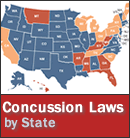The Education Commission of the States released an analysis Thursday comparing states’ youth-concussion laws to see what lies ahead for such legislation.
All 50 states now have some form of a youth-concussion law on the books—Mississippi was the last to join the club earlier this year—although some states’ laws are far more expansive than others. According to the ECS analysis, about half the state laws require coaches to complete a concussion-management training program (some annually, some biannually), and 80 percent require coaches to receive information on recognizing concussions. Thirteen of the states’ laws extend coverage beyond public school sports to private schools or youth athletic leagues, while 12 offer immunity from civil liability to school districts and employees, officials, volunteers and/or medical personnel.

Most states’ laws contain the three major facets of Washington state’s Lystedt Law: requiring concussion education for athletes, coaches, and/or parents; requiring student-athletes suspected of a concussion to be immediately removed from play; and requiring concussed student-athletes to receive clearance from a medical professional before being allowed to return to play.
With all states now having youth-concussion laws, the ECS analysis focused on the next steps of such legislation:
Will states take involvement in concussion prevention and response in a different direction? Will they allow sports organizations to pass their own sport-specific rules, which may be more effective and cross state boundaries? Will they follow the emerging science in improving diagnoses and monitoring?"
The analysis focused on three emerging innovations—baseline concussion testing, a pin-prick blood test, and an iPad app—as possible tools to consider in revising these laws.
Medical professionals can use the results from baseline testing to compare a student-athlete’s cognitive function when he or she is suspected of a concussion. The Centers for Disease Control and Prevention recommends schools conduct most components of student-athletes’ baseline tests on an annual basis, while computerized or paper-pencil neuropsychological tests can be repeated every two years.
The other two innovations discussed in the analysis—the pin-prick blood test and the iPad application—are far more experimental. Researchers at the Cleveland Clinic and the University of Rochester designed the blood test to measure a specific brain protein that leaks into the blood stream following a brain injury. The detection of this could offer a more definitive diagnosis when a student-athlete is suspected of a concussion. Cleveland Clinic researchers also developed an iPad app that uses a gyroscope and accelerometer to detect balance problems. If a student-athlete is suspected of a concussion, he or she could strap the iPad on his or her back and walk around, which could help aid in the diagnosis of a concussion.
The analysis also addresses the idea of a “return-to-learn” plan, which the American Academy of Pediatrics tackled in a clinical report last October. In short, concussed student-athletes may need to be eased back into their typical academic routine after sustaining such an injury. Bills introduced this year in Virginia and Nebraska would establish specific “return-to-learn” protocols that would allow for the modification of curriculum for a concussed student-athlete, upon a recommendation from a concussion-trained health-care provider.
.